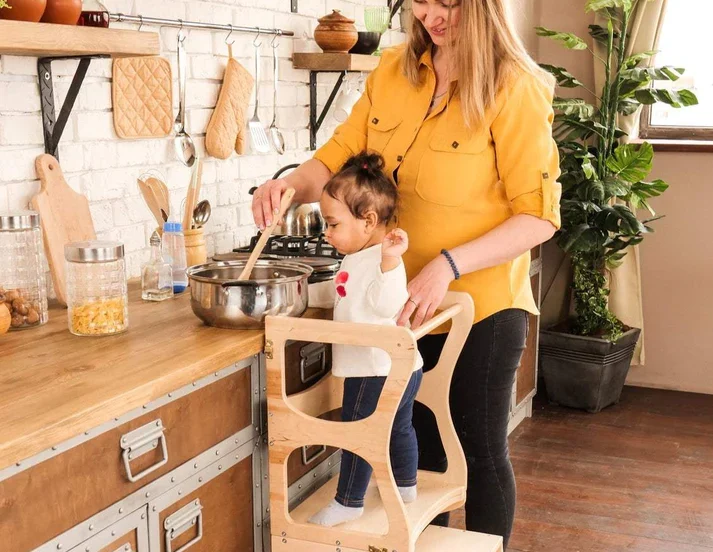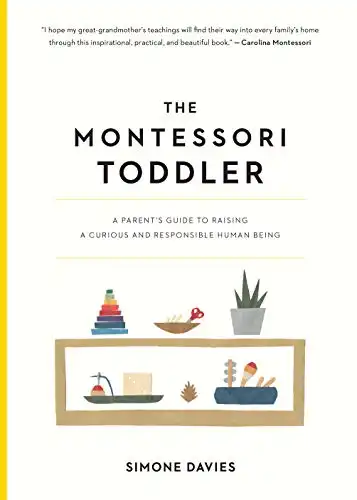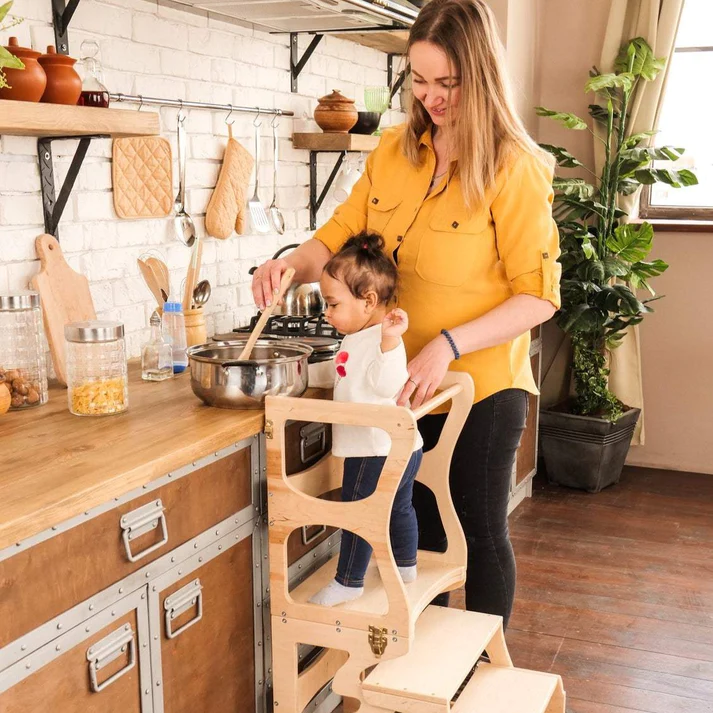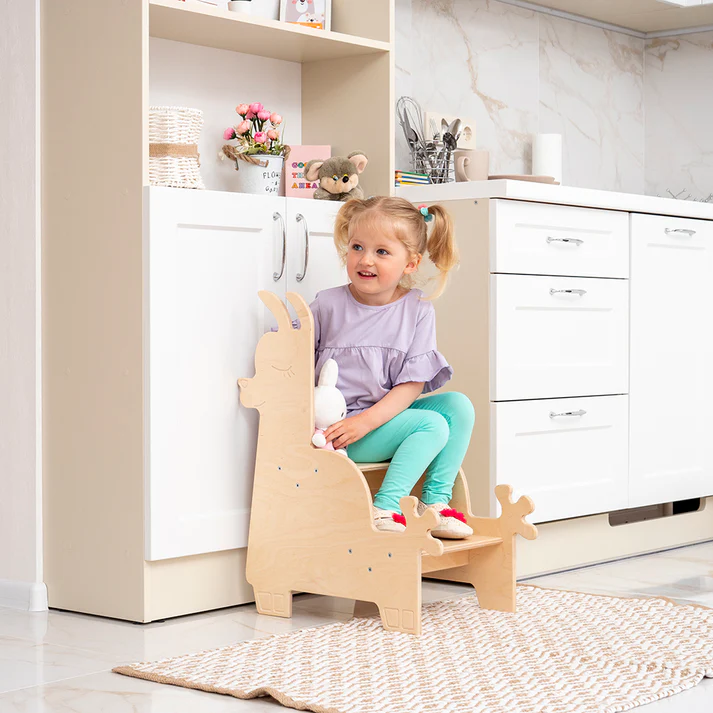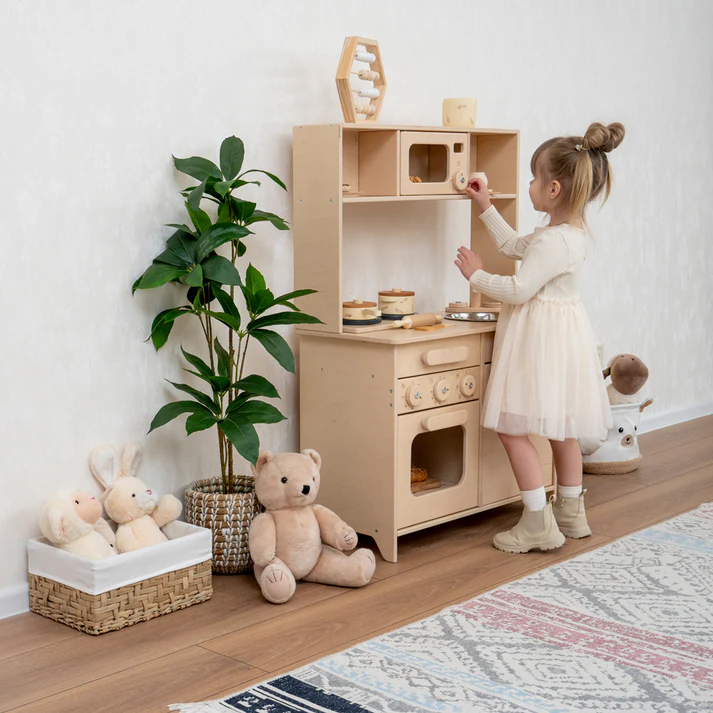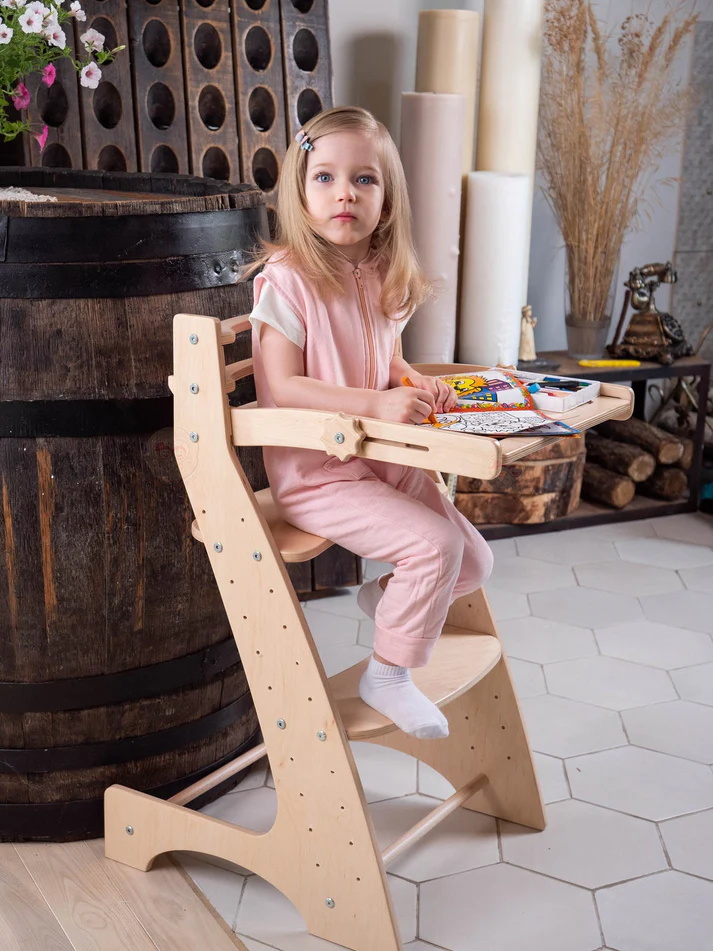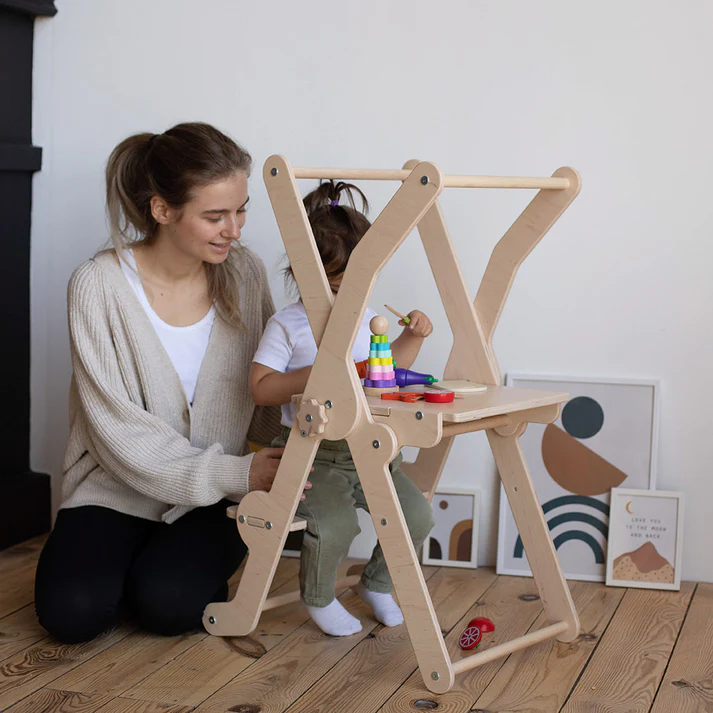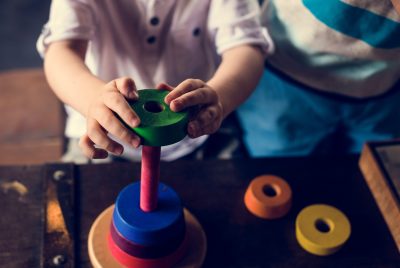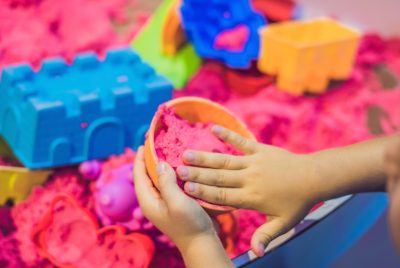Montessori Kitchen Design & Setup: Empowering Little Chefs
Ive grown to love the Montessori philisophy in recent years and I’ve seen firsthand the transformative power of integrating Montessori principles into the home, particularly in the kitchen. The Montessori kitchen design isn’t just about creating a cute space in your home; it’s about fostering independence, confidence, and practical life skills from a very young age. So, let’s dive into how you can set up a Montessori kitchen that empowers your little chefs to explore, learn, and grow.
In This Article
Understanding the Montessori Philosophy
The Montessori Method emphasizes self-directed activity, hands-on learning, and collaborative play. In the kitchen, this translates to an environment where children can engage in cooking activities at their level of development, fostering a sense of independence.
Encouraging independence in young children builds their confidence and self-esteem, essential components of the Montessori philosophy. A Montessori kitchen allows children to participate in daily life activities, helping them feel valued and capable.
Benefits Of A Montessori Kitchen
A Montessori Kitchen, whether it’s a fully functional kitchen designed for child participation or a play kitchen tailored for imaginative play, provides numerous benefits for children’s development. These benefits align with the Montessori philosophy of fostering independence, respect, and practical life skills from an early age. Here are some of the main benefits of a Montessori Kitchen:
Fosters Independence and Autonomy: Children learn to perform tasks on their own, from simple activities like pouring water and preparing snacks to more complex cooking projects. This independence boosts their confidence and self-esteem, as they see themselves as capable and competent individuals.
Encourages Practical Life Skills: A Montessori Kitchen is a practical environment where children can learn life skills that are essential for their development. This includes cooking, cleaning, organizing, and following recipes or instructions. These skills not only prepare them for real-life situations but also enhance their sense of responsibility.
Enhances Fine Motor Skills and Coordination: Handling kitchen tools, measuring ingredients, and performing tasks like cutting, peeling, or stirring help in developing fine motor skills and hand-eye coordination. These activities require precision and care, which contribute to the child’s physical development.
Promotes Healthy Eating Habits: By participating in the preparation of meals, children gain a deeper understanding and appreciation for food. This hands-on experience with various ingredients encourages them to try new foods and develop healthy eating habits early on.
Supports Cognitive Development: Cooking involves a lot of math, science, and language skills which helpd with STEM learning. Children learn about quantities, measurements, sequences (first, next, last), and the science behind how ingredients transform during cooking. Following recipes enhances reading comprehension and vocabulary.
Cultivates Social Skills and Family Bonding: Working together in the kitchen encourages cooperation, communication, and teamwork. It’s a shared activity that can strengthen bonds between children and adults, as well as among siblings or peers in a classroom setting.
Encourages Creativity and Exploration: A Montessori Kitchen is a creative space where children can experiment with flavors and textures. It’s a safe environment for them to express their creativity, try out new ideas, and learn from their successes and mistakes.
Teaches Respect for the Environment and Organizational Skills: Children learn to clean up after themselves, recycle, and conserve resources like water and food. Organizing tools and ingredients in the kitchen also teaches them valuable organizational skills and respect for their environment and belongings.
Boosts Problem-Solving Skills: Cooking and kitchen-related tasks often present challenges that require problem-solving. Whether it’s figuring out how to fix a recipe gone wrong or determining the best way to cut a vegetable, children learn to think critically and find solutions.
Provides a Sense of Accomplishment: Completing a task from start to finish, especially one that results in a tangible (and edible) outcome, provides children with a profound sense of accomplishment and pride in their work. This reinforces their motivation to take on new challenges.
Key Peices Of Montessori Furniture
A Montessori kitchen is characterized by child-sized furniture, accessible storage solutions, and safe kitchen tools. These elements ensure that the kitchen is a welcoming space for children, encouraging them to participate actively. Creating a Montessori kitchen involves selecting items that promote independence, safety, and practical life skills for children. Here are some of the most popular items needed in a Montessori kitchen:
Toddler Learning Tower (Adjustable Kitchen Helper Stool)
A Toddler Tower has a sturdy, adjustable platform that allows children to safely reach countertop height. It’s designed to be stable and secure, with sides to prevent falls.
This clever piece of Montessori Furniture Encourages participation in cooking and preparation activities by giving children a safe way to be at the same level as the kitchen counter. It fosters independence and inclusion in family cooking times.
A Kitchen Step or Stool
A stable stool is an essential in a Montessori Kitchen. It will help children to reach sinks, counters, and shelves safely. Ideally, it should be sturdy and slip-resistant.
Enables children to wash hands, dishes, and participate in cooking activities independently, fostering a sense of achievement and self-reliance.
Utensil Sets
Choose utensil sets that are ergonomically designed for children, including spoons, forks, spatulas, and whisks.
Providing this equipment to your children help to supports the development of eating and cooking skills. Child-sized utensils are easier for little hands to manage, enhancing their coordination and encouraging independence during mealtime.
Montessori Play Kitchen
A Montessori wooden play kitchen is a thoughtfully designed, child-centered playset that emulates a real kitchen environment using natural materials and realistic features.
Through pretend cooking and engaging with various kitchen tools, kids develop cognitive, fine motor, and social abilities while enjoying endless hours of fun and educational play.
Welcome to the world of Montessori play kitchens, where learning and fun come together to ignite your child's imagination and culinary skills.
- Teaches children loads of important life skills
- Encourage cooperative play, sharing, and communication among peers
- Suitable kids from 1 to 6 years old.
Open Ended Play, a hallmark of a Montessori toy kitchen, empowers children to explore and create freely without predefined outcomes.
A Montessori Weaning Chair
Unlike traditional high chairs, Montessori high chairs (or sometimes called weaning chairs) are designed to promote independence among toddlers and young children.
A Montessori Weaning Chair is a product that truly offers impressive functionality, serving as a chair, a convenient step, a feeding table, and a concise and safe ladder that a child can use to assist you in the kitchen or reach a shelf with their favorite books and toys.
- The product is designed for children from 8 months to 6-8 years old (depending on the child's height).
- The chair is adjustable and adaptable to the child's needs. The seat height, footrest, and the distance between the chair back and the table can be adjusted separately. This adjustment is easily done, allowing for daily customization.
- The Montessori weaning table and chair add the beauty of natural wood texture to your interior. The minimalist design easily complements other furniture elements.
Cleaning Set
Encourage your children to participate in cleaning up after cooking or eating, teaching responsibility and care for their environment. It also fosters practical life skills and a sense of community.
This colourful Melissa & Doug childrens cleaning set looks just like the real thing. It includes a wooden pretend play broom, mop, duster, dustpan and brush, and organising stand; the red dustpan conveniently clips into all handles.
Montessori Kitchen Design Ideas
Designing a Montessori Kitchen requires thoughtful consideration to create an environment that is safe, functional, and conducive to fostering independence and learning in children. Here are some important aspects to consider when planning your Montessori Kitchen
Child-Sized Furnishings and Accessibility: Everything in a Montessori Kitchen should be scaled to the child’s size. This includes tables, chairs, and even countertops if possible. Child-sized appliances, if available, can also enhance the experience. The key is for children to be able to access and use the space and its tools without adult assistance, fostering independence and self-confidence
Open Shelving and Easy Access to Tools and Ingredients: Use open shelving and transparent containers so that children can see and reach their tools and ingredients. Everything should have a specific place, and items should be organized in a way that makes sense to the child. This setup encourages children to be self-reliant and to participate in cleaning and organizing, which are important Montessori principles.
Safety First: Safety is paramount in a kitchen designed for children. This includes choosing tools that are safe for children to use, such as knives with rounded tips and appliances with safety features. Additionally, consider installing safety locks on drawers and cabinets containing items that are not suitable for child use, and ensure that the kitchen layout minimizes potential hazards.
Practical Work Surfaces and Cleaning Stations: Include work surfaces that are durable and easy to clean, as well as accessible sinks or cleaning stations where children can wash their hands and clean up after themselves. Consider a Montessori Step Ladder or a learning tower to safely elevate the child to counter height if adjustable counters are not an option.
Natural Materials and Aesthetics: Montessori spaces often emphasize natural materials and light-filled, calming environments. Choose wood, stone, and other natural materials for furnishings and tools where possible. Aesthetically pleasing and organized spaces not only attract children but also help in maintaining their focus and calmness.
Incorporate Learning and Educational Elements: A Montessori Kitchen is a perfect place to incorporate educational elements in a natural way. Label drawers and containers with words or pictures to encourage literacy. Integrate math by using measuring cups and spoons, and introduce science concepts through cooking and food preparation.
Adaptability and Flexibility: Children grow quickly, so consider how your Montessori Kitchen can adapt to their changing needs. Adjustable shelving, modular furniture, and tools that can serve multiple purposes will extend the life and usefulness of your kitchen.
Engagement and Sensory Experiences: The kitchen is a sensory-rich environment. Incorporate elements that engage the senses, such as a variety of textures, colors, and smells. This not only makes the experience more enjoyable for children but also supports their sensory development.
Space for Creativity and Personalization: Allow children to have a say in the setup and decoration of the kitchen space. This could mean choosing colors, deciding where certain items should go, or having a special place for their own creations. Personalization makes the space more inviting and gives children a sense of ownership.
Community and Social Interaction: Design the space in a way that encourages cooperation and interaction. This could mean having a large enough work area for multiple children to cook together or arranging seating in a way that facilitates conversation and shared meals.
The Role of the Adult in the Montessori Kitchen
As an adult, your role is to guide rather than do. This means setting up the environment for success, demonstrating tasks, and then stepping back to allow children to take the lead. Foster a sense of curiosity and exploration in the kitchen. Encourage children to experiment with flavors and textures, and to see cooking as a fun and creative process.
Overcoming Challenges in a Montessori Kitchen
Setting up a Montessori kitchen can present challenges, such as space limitations and budget constraints. However, with some planning and creativity, these obstacles can be overcome.
Space Limitations: Maximize the use of vertical space with shelves and hanging storage solutions. A foldable kitchen tower is perfect for those of you who have a limited amount of kitchen space.
When not using it as a tower, your child can comfortably sit on the table and use it for drawing, writing, playing, and more. The foldable kitchen tower offers a seamless transition from practicality to leisure, enhancing your child’s overall learning and play experience.
Introducing our innovative foldable tower for learning, a space-saving and versatile solution that empowers your child to safely explore the world of learning and creativity at countertop height.
- Versatile stool designed to serve as a tower helper or desk table
- For kids from 8 months to 4 years old
- Unfold it in seconds for effortless setup.
Budget Constraints: Look for second-hand furniture and kitchen tools, and prioritize investments in a few high-quality items that will be used frequently. DIY projects can also help stretch your budget further.
Join A Community: Joining a community of like-minded parents and educators can provide support and inspiration for your Montessori kitchen journey. Sharing your experiences can also help others who are just starting out.
Learn from Others: Connect with others through online forums, social media groups, or local meetups. Sharing tips, challenges, and successes can provide valuable insights and encouragement.
Closing Thoughts From Me
Setting up a Montessori kitchen is a rewarding journey that nurtures your child’s independence, creativity, and love for learning. By creating an environment that encourages exploration and participation, you’re giving your child a valuable gift that will serve them well throughout their life.
Remember, the goal is not perfection but progress. Each step you take towards creating a Montessori-inspired space is a step towards fostering your child’s growth and development. So, why not start your Montessori kitchen journey today? The benefits are immeasurable, and the memories you’ll create are priceless.
FAQs
What age is appropriate for introducing a child to the Montessori kitchen? Children as young as 18 months can begin participating in simple kitchen activities, such as washing fruits and vegetables or stirring ingredients. As they grow, you can introduce more complex tasks tailored to their abilities.
How can I ensure the kitchen is safe for my child? Invest in childproofing tools like cabinet locks, corner protectors, and safety gates. Choose child-friendly kitchen tools and always supervise your child, especially during tasks that involve heat or sharp objects.
Can I create a Montessori kitchen in a small space? Absolutely! Focus on creating a dedicated area for your child with accessible tools and ingredients. Use vertical storage solutions and multi-functional furniture to maximize space.
What are some essential Montessori kitchen tools for children? Toddler Learning Towers, cutting boards, knives with safety features, step stools, and utensils designed for small hands are great starters. These tools help children participate more fully and safely in kitchen activities.
How can I involve my child in the cooking process without creating a mess? Start by setting expectations and teaching basic cleanup skills. Use trays and mats to contain spills and encourage your child to clean up as part of the cooking process. Remember, a little mess is part of the learning experience!

